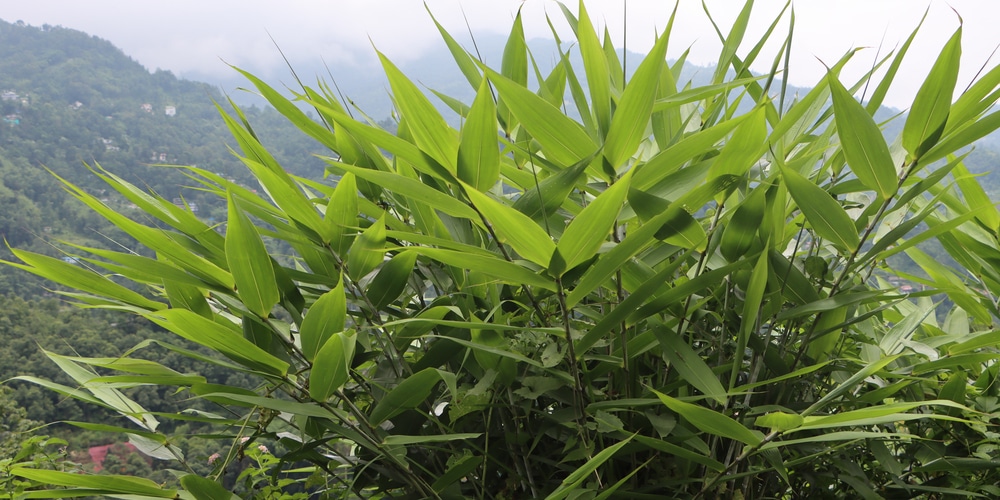Tropical climates with high humidity are ideal for growing tiger grass. Tiger grass is a clumping perennial grass native to Southern Asia, where it is commonly used to wrap food. Let’s look at how to grow and care for a tiger grass plant.
What is Tiger Grass Plant

Thysanolaena Maxima is the botanical name for this plant, and it resembles sugarcane and bamboo in appearance. Tiger grass is among the most regularly farmed grasses because of its ease of cultivation. In spite of its beauty, it can grow quite large if it is not properly maintained.
The rhizome of this perennial grass is comparable to a corm or bulb. With its broad, variegated leaves, it swiftly grows into a dense cluster that can grow up to 2.7 meters, with a diameter of up to 6 feet (1.8 meters). Late in the summer or early in the fall, tall plumes of small purple blooms emerge.
Because of their large size, these plants are ideal for use as a privacy screen around swimming pools and other outdoor spaces. The full height of the tiger grass hedge creates an eye-catching property line boundary. In addition, if planted in large, solid pots and watered regularly, they can make excellent container plants. Plants grown in containers are often smaller than those grown in the garden.
Tiger grass offers a wide range of applications. It can be found in Korean cuisines as a wrap for grilling or steaming meals. The robust stalks can be trimmed and used as garden supports for tall blooming plants or tomatoes. These plants are used to manufacture brooms; the bamboo-like stems serve as sturdy handles, and the flower panicles serve as the broom’s parts.
How to Grow Tiger Grass Plant
Tiger grass can be grown in either partial shade or full sun, but it prefers rich soil and enough water to thrive. Humid tropical settings are ideal for it because it is prone to hypothermia. Although it will not endure freezing winter temperatures, the grass rhizome can be unearthed and stored until spring, after which it can be replanted after the soil is warm.
Like many ornamental types of grass, Tiger grass can outgrow even the largest of gardens. Pruning regularly will keep it at a moderate height. Rhizomes can be separated to produce multiple tiny plants, but digging them up might be challenging. The best tool for this job is a shovel with a pointed tip.
Ordinarily, decorative grasses can be obtained in major garden stores or nurseries, but they are more frequently found via mail order or on the internet. A naked rhizome of this grass can also be obtained; however, it is more commonly offered as a potted plant. Both need to be planted as soon as possible, preferably in a large pot, and watered well. Adding fertilizer to the tiger grass before planting might help it thrive.
Tiger Grass Planting Instructions
Tiger grass plants can be grown in full sun or moderate shade, so dig a hole 2-3 times larger than the root mass.
Soil
If the soil contains a high concentration of clay or sand or is deficient in fertility, break up the soil in an area that extends at least a foot beyond the hole. Make sure the soil includes up to half of an organic supplement.
Examine the roots
To ensure that the root mass of tiger grass is healthy, remove it from the wrap or container and examine it closely. Remove any dead or broken roots using a sharp knife, leaving only firm, healthy roots behind.
Planting Tiger grass plant
Place the root mass of the tiger grass in the middle of the hole you just dugout. The grass should be planted at the same depth as previously, which may mean adding or removing dirt from beneath the root mass as necessary.
Using your hands, gently compact the earth around the grass root so no significant air pockets remain.
Watering
Immediately after planting, water the soil thoroughly around the grass to keep it from drying up. If necessary, add more soil to compensate for settling. Once rooted, tiger grass is relatively drought tolerant; however, continuous hydration around the roots of this plant throughout the first growing season after planting and during prolonged dry periods will increase plant vigor and a pleasing aesthetic look.
Things you need
* Shovel with a good edge
* If necessary, add organic matter to the soil.
* A sterile, sharp knife
* Watering can or hose
Tiger grass plant: Final thoughts
Apply a loose, 3-inch-thick layer of organic mulch, such as shredded leaves around the tiger grass or bark, but not directly on it. This will aid in conserving soil moisture and regulating soil temperature in the vicinity of the grassroots.
